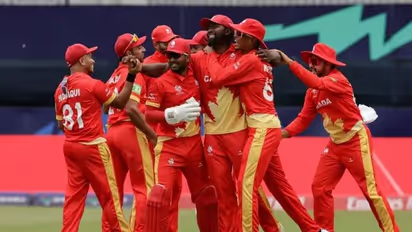T20 World Cup 2024: The journey of Punjabi cricketers in the Canadian team

Synopsis
Canada’s cricket team is a melting pot of diverse cultures, with Punjabis like Navneet Dhaliwal, Pargat Singh, and Kaleem Sana finding a new home in cricket. Despite language fines and cultural differences, their shared passion for the sport unites them in their quest to elevate Canadian cricket on the international stage.
In the Canadian cricket team, players are fined for not speaking English to prevent forming small groups based on language or ethnicity. However, when two Punjabis come together, as Navneet Dhaliwal puts it, "only Punjabi comes out." Canada has more than just two Punjabis, both from eastern and western Punjab. "It's hard," says Dhaliwal. "We just keep paying fines."
Punjabi is a difficult language to resist. Even Caribbean-born players in the Canadian team request Punjabi songs by artists like Sidhu Moose Wala and Shubh to dance to. For more gravitas in Punjabi music, they look to Pakistan.
Pargat Singh: From Punjab to Canada
Pargat Singh, born in Ropar in 1992 and raised in Jalandhar, was an opening batter for Punjab through various age groups. Despite his talent, he struggled with the politics of the senior team. Whenever Yuvraj Singh or Harbhajan Singh advocated for him, he played. When they weren't around, he was sidelined. This inconsistency led him to move to Canada at 24, where his brother already lived.
In Canada, Pargat drove Uber and played cricket on weekends. Despite his family's pleas and friends' encouragement, he had lost his patience and gave up serious cricket. "That period of 2009 to 2014 was very hard on me," Pargat says. "I was aggressive in my decision-making. I didn't have a mentor in cricket, and didn't listen to anyone outside. I had given up from inside. 'Why is it happening to me?'"
Kaleem Sana: A Star Dimmed by Injury
Kaleem Sana, from Rawalpindi in the western side of Punjab, debuted in first-class cricket at 15 and was part of the Pakistan Under-19 squad. However, an injury in Zimbabwe before the World Cup fractured his L4 and L5 vertebrae, ending his World Cup hopes and his pace. The injury left him in a dark place, with anxiety and possible depression.
Sana moved to Canada in 2015, sponsored by a friend, and played cricket on weekends while doing various odd jobs. In 2017, he saw Pargat play and pushed him to take cricket seriously again. Initially reluctant, Pargat eventually gave in, thanks to his mother and his continued gym training.
A Cricketing Brotherhood in Surrey
In Surrey, Vancouver, a house owned by cricket lover Khurram Dilshad became a shared resting space for cricketers. Pargat lived there when he started trying to make it to the Canadian team. Sana made his international debut for Canada in February 2022, with Pargat following in November that year. When Canada regained their ODI status in Namibia, Pargat was the highest run-getter.
A United Team with Diverse Roots
Talking to them during the India-Pakistan fervor, it's evident how disillusioned Indian and Pakistani Punjabis push each other to rediscover the sport. Dhaliwal, who played all his cricket in Mohali, recalls his early days with Shubman Gill. "I threw the first balls at him when he moved to Mohali," Dhaliwal says. "His dad asked me to throw balls at him to see how good he is. He must have been eight. I was in the Under-17 group. I still remember it clearly. I could see god had put talent in him."
Dhaliwal's father took a risk and moved to Canada, where Dhaliwal eventually followed. Studying and helping with the family business, he also began coaching cricket. "It is more fun with different cultures," Dhaliwal says. "We get dance moves from the Caribbean-born guys, food from the Pakistanis, Sidhu Moose Wala and Shubh from us."
Cricket's Growth in North America
Canada plays Pakistan and India in quick succession, with a USA vs India match in between. If Canada manages an upset, they could make the Super Eights. Dhaliwal emphasizes the importance of North American teams doing well. "We want the world's attention. We keep playing US as close rivals, we win too, we lose some, but the more the cricket grows in US, the better it is for Canada."
Stay on top of all the latest Sports News, including Cricket News, Football News, WWE News, and updates from Other Sports around the world. Get live scores, match highlights, player stats, and expert analysis of every major tournament. Download the Asianet News Official App to never miss a sporting moment and stay connected to the action anytime, anywhere.